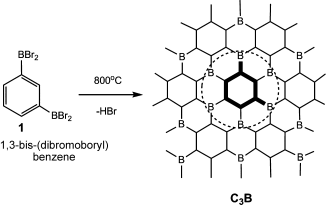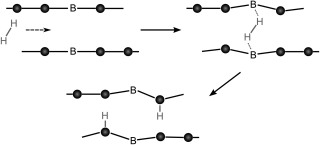T.C. King, P.D. Matthews, H. Glass, J.A. Cormack, J.P. Holgado, M. Leskes, J.M. Griffin, O.A. Scherman, P.D. Barker, C.P. Grey, S.E. Dutton, R.M. Lambert, G. Tustin, A. Alavi, D.S. Wright
Angewandte Chemie (International Edition), 54 (2015) 5919–5923
doi: 10.1002/anie.201412200
Previous theoretical studies of C3B have suggested that boron-doped graphite is a promising H2– and Li-storage material, with large maximum capacities. These characteristics could lead to exciting applications as a lightweight H2-storage material for automotive engines and as an anode in a new generation of batteries. However, for these applications to be realized a synthetic route to bulk C3B must be developed. Here we show the thermolysis of a single-source precursor (1,3-(BBr2)2C6H4) to produce graphitic C3B, thus allowing the characteristics of this elusive material to be tested for the first time. C3B was found to be compositionally uniform but turbostratically disordered. Contrary to theoretical expectations, the H2– and Li-storage capacities are lower than anticipated, results that can partially be explained by the disordered nature of the material. This work suggests that to model the properties of graphitic materials more realistically, the possibility of disorder must be considered.



